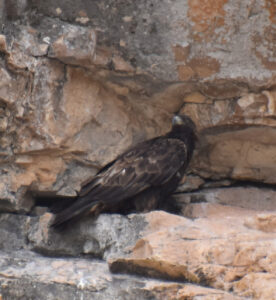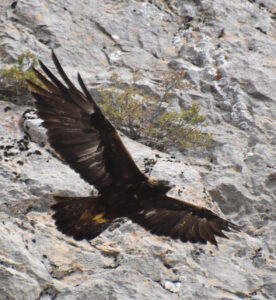Third International Scientific and Practical Conference “Eagles of the Palearctic: Study and Conservation”
Raptors Conservation. Suppl. 2. Proceedings of Conferences
About the population of the Golden Eagle in the Eastern part of the Kyrgyz Range, Northern Tian Shan, Kyrgyzstan
Ostashchenko A.N., Zakharov A.Yu. (Institute of Biology, NAS KR, Bishkek, Kyrgyzstan)
Contact:
Anatoly Ostashchenko aostas@yandex.com
Andrey Zakharov azaharov230361@mail.ru
Recommended citation: Ostashchenko A.N., Zakharov A.Yu. About the population of the Golden Eagle in the Eastern part of the Kyrgyz Range, Northern Tian Shan, Kyrgyzstan. – Raptors Conservation. 2023. S2: 22–25. DOI: 10.19074/1814-8654-2023-2-22-25 URL: http://rrrcn.ru/en/archives/34826
The material for this paper is based on occasional observations of the Golden Eagle (Aquila chrysaetos) over a 30-year period and on breeding data collected from March 21 to April 14, and from May 21 to June 14, 2019, in the foothills and middle mountains of the northern macro slope of the Kyrgyz Range, from the Boom Valley in the east to the Kara-Balta area in the west. This territory is stretching on 170 km. The main goal of the fieldwork was to search for Saker Falcon’s (Falco cherrug) nests, thus information about the Golden Eagle’s nests was collected mostly occasionally. Nevertheless, these data objectively reflect the current state of the population.
During the survey period six active nests of the Golden Eagle were discovered. One nest was located on a rock ledge, two nests were built within niches in conglomerate cliffs, and three nests were found on clay cliffs. In the latter case, the nests were built on the basis of shrubs growing on the cliffs.
Usually, the contents of the nests were not observed. Only in one nest an egg was seen on March 26, and on May 23 the nest contained a fledgling with growing flight feathers.
In total, during the field trip, 11 adult and two juvenile Golden Eagles were encountered, excluding territorial birds observed near the nests.
The Golden Eagle is present in the Kyrgyz Range all year round. It appears that a pair consistently maintains its nesting territory driving all other large eagles away. For instance, on December 3, 2018, in the foothills of the Kyrgyz Range, we observed two Golden Eagles relentlessly chase and attack an Imperial Eagle (Aquila heliaca). Breeding displays were observed near the Orto-Tokoy Reservoir on January 22, 2010. Young eagles spend the winter with their parents, who continue to feed them occasionally. In various locations within the Tien Shan range, groups of three birds, including one juvenile, are encountered throughout the winter. Presumably, during the incubation period, parents drive young birds away from themselves, at least from the vicinity of the nesting site. For instance, on April 7, 2019, in the Beyisheke area, a pair of adults persistently chased a juvenile away from their nest. However, even during this time, it is possible to observe both adult and young Golden Eagles soaring together.
Actually, the main mystery of the ecology of Golden Eagles nesting in the foothills is the structure of their spring-summer diet. There are no marmots (Marmota sp.) here, the desert hare (Lepus tibetanus) is rare in most of the area, as well as the chukar (Alectoris chukar) and the pheasant (Phasianus colchicus). Perhaps snakes play a significant role in its summer diet, since we have seen Golden Eagles carrying a snake several times. The earliest case of carrying a snake was noted as early as March 21.
The local people’s attitude towards this species is mostly favorable. Three nests were located near roads and were clearly visible from them. Two nests were situated no more than a kilometer away from residential livestock enclosures, where domestic chickens and turkeys were kept alongside sheep. However, Golden Eagles do not attack domestic birds or lambs. This behavior allows them to peacefully coexist with livestock farmers for many years. Generally, the human attitude towards the Golden Eagle in the Kyrgyz Range is mostly neutral. Occasionally, it is kept for falconry purposes, but there are few enthusiasts left, and nowadays it is more of a show than a substantial practice. As a result, Golden Eagle’s population is not significantly impacted by falconers. The trend of making stuffed animals, which was very popular in the late XX and early XXI centuries has almost disappeared. Occasionally, Golden Eagles die in traps set on other animals. There is a known case of a car accident with a Golden Eagle in the Boom Valley. As a result, the bird lost its sight. In May 2019, a dried-up carcass of a Golden Eagle was found beneath the aerial power line. Upon examination, it was discovered that half of its wing was severed with a very clean cut along the ulna and radius bones. This undoubtedly indicates a high speed collision. Most likely, the bird dived for prey and did not notice a conductor at least 10 centimeters thick against the background of the mountains.
In total, the number of discovered nests, their location in areas of high human activity, and the attitude of the local population are driving us to the conclusion that the population of the Golden Eagle in the eastern part of the northern macro slope of the Kyrgyz Range is in a favorable state.


